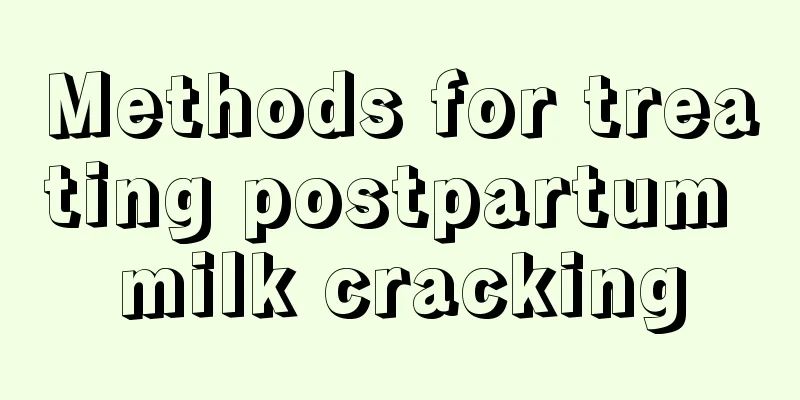Methods for treating postpartum milk cracking

|
Because you need to breastfeed after giving birth, sucking on the nipples for a long time will cause some wear and tear on the nipples. In addition, the nipples will become painful and cracked when the milk dries up, which will cause big problems with the nipples. In fact, it cannot be ruled out that it may be related to breast inflammation. In normal times, you can use some small folk remedies to slowly treat it and prevent the disease from worsening. Common problems with lactating breasts Common breast problems during lactation include: inverted nipple, nipple fissures, nipple eczema, mastitis, sagging breasts, uneven breast sizes, etc. Some of these have been mentioned above, and here we mainly introduce several other common breast problems. 1. Inverted nipples There are several reasons for inverted nipples. One is congenital reasons, and the other is acquired reasons such as malnutrition, or underwear or bra binders that are too tight. There are roughly three solutions: one is manual traction, which is mainly suitable for adolescence and is mainly for prevention when girls are just starting to develop. The second is attraction therapy, which is consistent with the principle of manual traction, but it is more of a professional treatment and requires a step-by-step approach to achieve good results. The third is surgical treatment. When the first two methods are unsuccessful, surgery is the only option to correct the problem of inverted nipples. However, the surgery may affect breastfeeding and is prone to recurrence. Before and after feeding, you can gently wipe the nipples and the surrounding skin with warm water. It is recommended that during daily breastfeeding, the baby should hold the skin of the nipple and areola as much as possible, which will make it easier to stimulate breast milk secretion. 2. Mastitis There are two main causes of mastitis: milk accumulation and bacterial invasion. It is not difficult to summarize prevention methods based on these two causes of the disease. First of all, avoid excessive milk accumulation in the breasts. Excess milk during lactation can be artificially squeezed out to promote smooth flow. In addition, special attention should be paid to breast hygiene and proper care should be taken to prevent bacterial invasion and pathological changes. If the mother's mastitis symptoms are severe, it is recommended to stop breastfeeding and switch to formula feeding to prevent the baby from drinking poor quality or spoiled milk. 3. Breast size is different First of all, slight differences in size are normal because the human body is not absolutely symmetrical from left to right. During the lactation period, the difference in breast size may be due to the mother's habit of using only one breast to feed the baby. Over time, one breast is often stimulated more than the other, causing it to grow faster than the other, resulting in different breast sizes. The way to avoid breast size differences is to feed the breasts alternately. This can prevent the breasts from being different in size and relieve fatigue in one arm. 4. Nipple eczema Nipple eczema is mostly caused by both internal and external factors. Internal factors such as digestive dysfunction, stress and insomnia, general fatigue and lack of rest may also cause eczema. External factors such as humidity, sucking by babies, excessive dryness, cold weather, and even common bathroom supplies in the home - soap, shower gel, etc. - may also cause eczema. Eczema is a minor ailment that may occur in normal life. As long as the cause is found, some living or eating habits are changed, and a doctor is asked to prescribe some auxiliary medications, and the condition continues to improve for a period of time, it will be fine. Breastfeeding mothers should pay special attention to eczema caused by babies sucking on the nipples. Once eczema is discovered, stop breastfeeding immediately. 5. Cracked nipples Nipple cracks usually occur in breastfeeding mothers. The main reason is caused by feeding the baby milk. Therefore, breastfeeding mothers should pay attention to the cleanliness and dryness of the breast area, and also pay attention to the cleanliness of the baby's mouth corners and oral cavity. This can effectively prevent nipple cracks caused by breastfeeding. If a mother unfortunately has cracked nipples, she should alternate feeding from both sides when breastfeeding her baby. It is also better to wear loose underwear for daily wear. |
<<: I'm about to give birth and I have diarrhea and water
>>: What to do if your breasts hurt after milking?
Recommend
Where to massage for blocked fallopian tube
When a woman has blocked fallopian tubes, her ovu...
What happens if there is blood in the leucorrhea after urination?
Some women may find blood in their leucorrhea aft...
How to deal with blood clots during menstruation?
Generally speaking, as long as the menstruation i...
What is the disease of a woman's lower back burning
If a woman's lower back feels hot, she should...
What are the precautions for hyperthyroidism during pregnancy and childbirth?
Many women will have a big appetite after becomin...
How many colors of leucorrhea are there?
Leucorrhea can usually appear in a variety of col...
Causes of high prolactin in women
Lactin is a peptide growth hormone. Exists in wom...
Leucorrhea appears twice a month
Stringy leucorrhea often occurs when you wipe you...
9 "side effects" of not eating staple foods to lose weight, how many do you have?
Author: Xue Qingxin Have you ever stopped eating ...
How can women replenish qi and blood?
There is nothing wrong with the fact that women a...
What to do about amenorrhea caused by obesity
I believe everyone knows what amenorrhea is. To p...
Is the pain on the left side of my lower abdomen due to pregnancy?
As we all know, women will have some signs before...
Is it okay for women to eat crabs?
Crabs are a type of seafood with very high nutrit...
What causes occasional bleeding after sex?
When couples have sex, some abnormal situations a...









